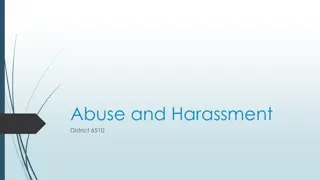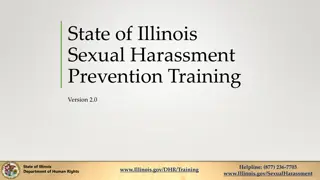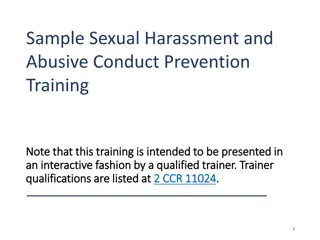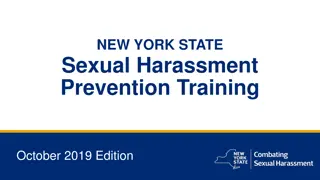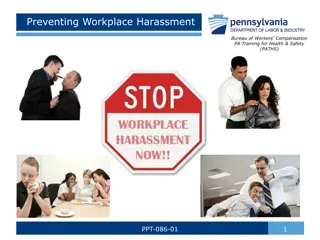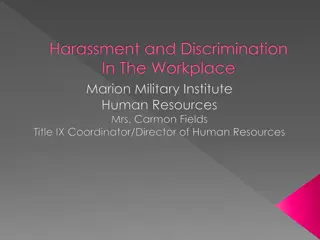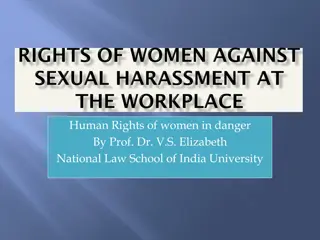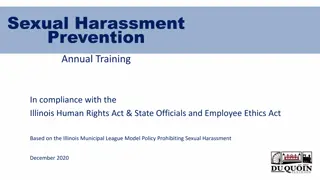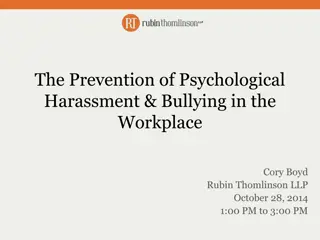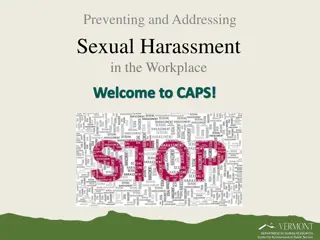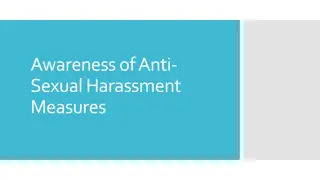Understanding Sexual Harassment in the Workplace
Sexual harassment is a prevalent issue at workplaces, with a significant percentage of women experiencing unwanted behaviors such as physical contact, stalking, and abusive communication. Despite this, many incidents go unreported due to fear of poor outcomes or worsened situations. It is crucial to recognize and address various forms of sexual harassment, including demands for sexual favors, threats, and creating hostile work environments. Education and enforcement of preventive measures are essential to ensure a safe and respectful workplace for all employees.
Download Presentation

Please find below an Image/Link to download the presentation.
The content on the website is provided AS IS for your information and personal use only. It may not be sold, licensed, or shared on other websites without obtaining consent from the author. Download presentation by click this link. If you encounter any issues during the download, it is possible that the publisher has removed the file from their server.
E N D
Presentation Transcript
Prevention of Sexual Harassment of Women at Workplace (PoSH) Ritu Goyal Ritu Goyal (Partner) (Partner) NAKS & Partners NAKS & Partners Advocates & Solicitors Advocates & Solicitors 28/142, West Patel Nagar, New Delhi 28/142, West Patel Nagar, New Delhi- -110008, M: 91 9582004704, Email: M: 91 9582004704, Email: ritu@nakslaw.com 110008, ritu@nakslaw.com
Women Work Participation 25.3% in Rural Areas; 14.7% in Urban Areas
How Common is Sexual Harassment at Workplace? 52% Women experience Sexual Harassment at Workplace; 25% touched without invitation; 20% experienced sexual advances; TUC Survey Perception
Why Dont women report? 1 out of 5 do report it; 80% thinks outcome is poor; 16% said that the situation worsened after they reported; TUC Survey Perception
What is Sexual Harassment? ANY UNWELCOME ACT or behavior SEXUAL in nature A SUBJECTIVE experience IMPACT not the Intent that matters
Sexual Harassment includes Physical contact Stalking Abusive Sounds vulgar/indecent jokes, phone calls, text massages, e-mails, Making sexually colored remarks Using sexually abusive language or signs in the presence of woman employee; Physical confinement or touches against the will and likely to intrude upon one s privacy; or Showing pornography or the likes; Demand or request for sexual favours;
Sexual Harassment includes Implied or explicit promise of PREFERENTIAL TREATMENT promise of PREFERENTIAL TREATMENT in her employment; or Implied or explicit THREATENING TREATMENT THREATENING TREATMENT in her employment; or Implied or explicit THREAT ABOUT PRESENT AND FUTURE THREAT ABOUT PRESENT AND FUTURE EMPLOYMENT STATUS EMPLOYMENT STATUS; or HOSTILE WORK ENVIRONMENT Interference with her work Interference with her work Humiliating treatment Humiliating treatment likely to affect her health or safety.
Physical Touch Creating Hurdles Any unwelcome act
What is at stake? Brand value Negative Publicity; Decreased Morale and decreased efficiency of employees; Loss of money for non-compliance of provisions of law Madras High Court awarded Rs. 1.68 Crores in damages to an employee for Non- Constitution of ICC.
Laws Governing Sexual Harassment The The Sexual Sexual Harassment Prohibition Prohibition and and Redressal) Harassment of of women Redressal) Act, women at at workplace Act, 2013 2013 and and Rules workplace (Prevention, (Prevention, Rules made made thereunder thereunder.. Indian Penal Code (Section 209, 354, 376 and 509), 1860; and Industrial Employment (Standing Orders) Act, 1946
Prevent Sexual Harassment No women employee to sexual harassment at workplace Section 3(1) of the Act employee shall be subjected workplace
Employees Responsibility Understand Observe Examine Confront Resolve Support
Who is Employee? Employee means a person employed by Company for any work and includes:- Employed on regular, temporary, ad hoc or daily wage basis; Either directly or through an agent, with or without the knowledge of the principal employer ; Whether for remuneration or not or working on a voluntary basis or otherwise; Whether the terms of employment are express or implied ; and Contractor, coworker, a contract worker, probationer, apprentice or called by any other such name .
What is Workplace? Workplace includes:- All premises including Corporate Office, head office, branch offices and all other premises, locations, establishments, institutions, units, sites controlled directly or indirectly but he Company and/or where from business of the Company is conducted; All other premises where employees of the Company visit arising out of or during the course of their employment including official events; and Includes the transportation and accommodation, if any, provided by the Company for employees arising out of or during the course of employment for commutation or residence purposes.
How to prevent? Following are the responsibilities of the employer under the Act:- Constitution of Internal Complaint Committee (ICC) to handle the complaints of sexual harassment; Display on the notice board of the premises giving full details of members of ICC; Display at conspicuous places at workplace, penalties & consequences of sexual harassment ; Providing training to sensitize the employees on the issues and implications of sexual harassment at workplace and organizing orientation programme(s) for members of ICC.
Internal Complaint Committee Every Employer needs to constitute ICC as per the provisions of the Act to take care of following matters:- To conduct enquiry into the complaints of sexual harassment; To make recommendations to the Board of Directors of your Company in the matters of sexual harassment after conclusion of enquiry; To file annual report as per the provisions of the Act
What to do? Don t ignore it. In the hope that it will go away. Don t blame yourself and don t delay. Be sure to say No clearly and firmly. Speak Out. Speaking out about sexual harassment is an effective tool in combating it.
What are the remedies? Any aggrieved woman employee may file a compliant with ICC for Redressal of her grievances. It is the responsibility of ICC to send notice to (against whom a complaint of sexual harassment made) within 7 (seven) working days. Respondents has been The Respondent shall file his reply to the complaint along with supporting documents.
Procedure of filing Complaint Any aggrieved woman may make a complaint in in writing member of ICC writing with any at the prescribed prescribed contact contact details details, preferable within sexual harassment or in case of series of incidents, with in a period of 3 months from the date of last incident. within a a period period of of 3 3 months months of the date of incident of The Complainant shall file minimum minimum six six copies copies of the complaint. The complaint shall consists of name of the Respondent(s), date and details of incident of sexual harassment, name and details of witness, if any, along with the supporting documents.
Who is eligible to file a complaint? Aggrieved woman herself; Where the Aggrieved Woman is unable to make a Complaint on account of her physical or mental incapacity , a Complaint may be filed by any prescribed person, on her behalf; Where the Aggrieved Woman for any other reason is unable to make a Complaint, a Complaint may be filed by a person who has knowledge of the incident, with her written consent; Where the Aggrieved Woman is dead, a Complaint may be filed by any person who has knowledge of the incident, with the written consent of her legal heir(s).
Procedure of Enquiry CONCILIATION CONCILIATION The ICC may, before initiating an inquiry, at the request of the Aggrieved Woman, take steps to settle the matter between her and the Respondent. No monetary settlement shall be made as a basis of conciliation. The settlement terms shall be recorded in writing and forwarded to the Board of Directors of the Company. Copies of the same shall be provided to the Aggrieved Woman and the Respondent. Where a settlement has been arrived at, no further inquiry shall be conducted by the ICC.
Procedure of Enquiry ENQUIRY ENQUIRY In case, conciliation is not possible, ICC shall investigate the complaint and provide its report, as promptly as possible, but not later than 90 working days from the date of the Complaint. The ICC shall follow principles of natural justice in all its proceedings. Complete confidentiality shall be maintained, unless required by law. A copy of the Complaint as recorded by ICC shall be given to the Respondent as well as the Complainant. The Respondent shall submit his response to the Complaint as well as to indicate whether the Respondent wishes the ICC to examine any witnesses or furnish any evidence. The Complainant shall also indicate in writing whether the Complainant wishes the ICC to examine any witnesses or furnish any additional evidence.
Procedure of Enquiry Upon receipt of the responses from the Respondent and the Complainant, the ICC shall conduct a hearing, where both the Complainant and the Respondent shall be heard in person. ICC shall be empowered to call upon such of the Employees who may have been witness to the incident(s) of Sexual Harassment and/or connected in any manner thereto. All Employees shall extend their fullest co-operation to ICC. Upon completion of the hearing, the ICC shall prepare its complete report, setting out its recommendations on the disciplinary action(s) to be taken against the Respondent or Complainant (as the case may be).
Punishment for Sexual Harassment To take action for sexual harassment as an act of misconduct in accordance with the rules/regulations of the Company governing conduct and discipline as applicable to the Respondent; and/or and/or To deduct such amounts from the salary or wages of the Respondent as may be considered appropriate to be paid to the Complainant as per the Policy of the Company. Section 354, 354 A, 354B, 354 C, 354 D and 509 of Indian Penal Code, 1860 provides for punishment for offences of outraging the modesty of woman, sexual harassment, disrobe, voyeurism, stalking and insulting the modesty of woman respectively and the punishment ranges between rigorous imprisonment from 1 to 3 years AND fine or both.
Punishment for Malicious Compliant or False Evidence If an Employee is found to have raised a malicious or false Complaint or given any false evidence, such complainant or such person making evidence may also be subject to :- Appropriate disciplinary action, which may include termination of employment, engagement or relationship with the Company, as the case may be.
Absence of complaints of sexual harassment doesn t necessarily means absence of sexual harassment .....
Refrain from. Behavior that may offend or hurt people at your workplace; Behavior that cause harassment to any women employee at your workplace; Behavior that may be interpreted by another as sexual harassment; Behavior that may support sexual harassment in any manner; Disbelieving a woman when she shares about harassment. Remember that sexual harassment is UnwelcomeBehavior . Involvement in trivializing the matter of sexual harassment; Filing or supporting any malicious or false complaint; Producing any false evidence of sexual harassment.
What can you do... Be Professional all the time; Set a positive example; Think before making personnel comments; Be supportive of people who wish to talk about being sexually harassed; Direct them to the appropriate persons/authorities; Hold the harasser accountable for his actions. Don t make excuses for him; Demand that the harassment be stopped; Report sexual harassment to responsible person in the organisation.
Say No to Sexual Harassment Let s make this Earth a safe and healthy Workplace
Thank You Ritu Goyal Ritu Goyal Advocate, FCS, B. Com Advocate, FCS, B. Com Partner, Partner, Naks Naks & Partners Team Team & Partners









